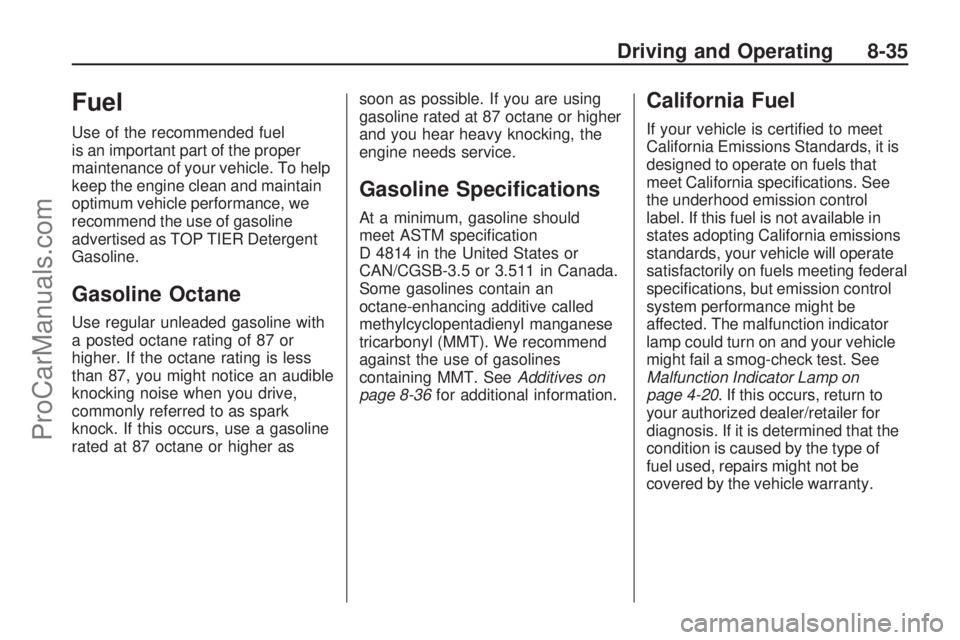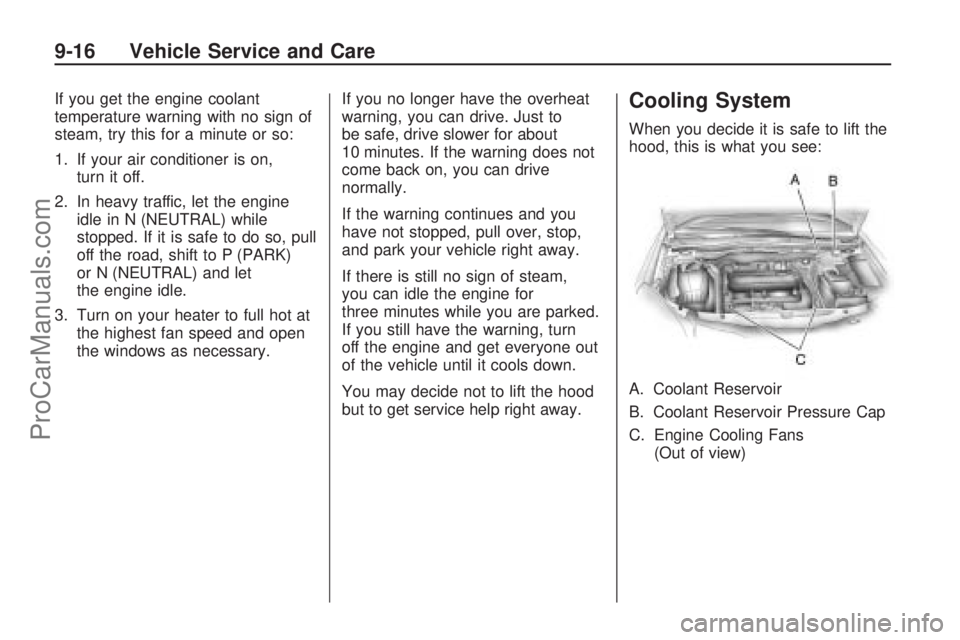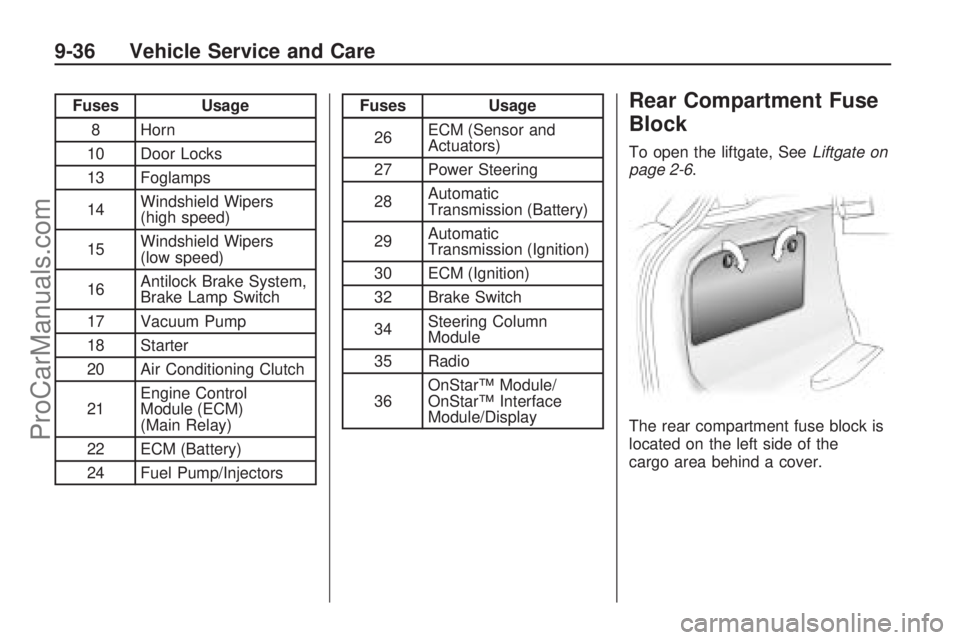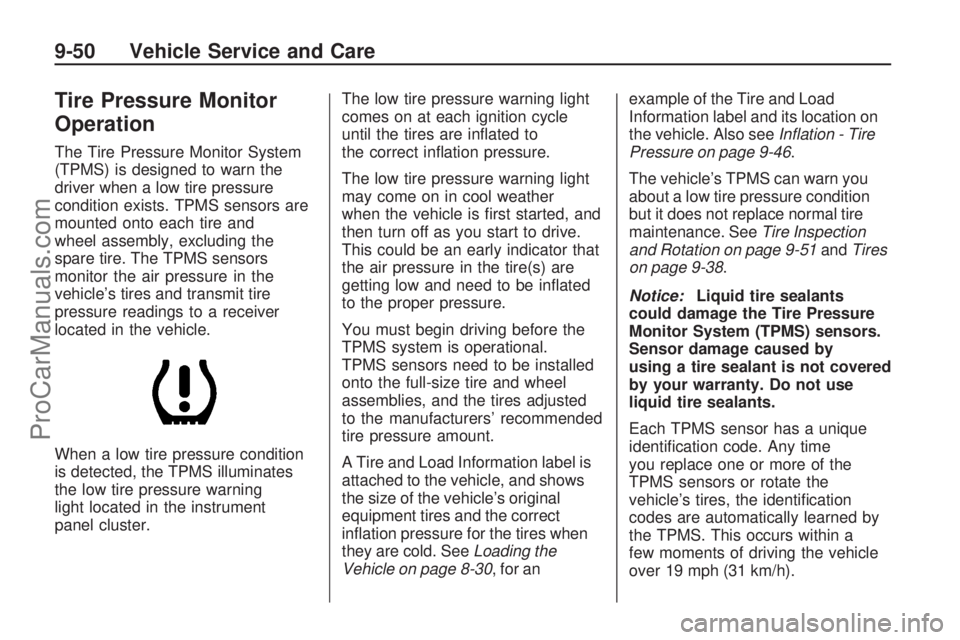air condition SATURN ASTRA 2008 User Guide
[x] Cancel search | Manufacturer: SATURN, Model Year: 2008, Model line: ASTRA, Model: SATURN ASTRA 2008Pages: 304, PDF Size: 1.92 MB
Page 176 of 304

If your vehicle starts to slide, ease
your foot off the accelerator pedal
and quickly steer the way you want
the vehicle to go. If you start steering
quickly enough, your vehicle may
straighten out. Always be ready for a
second skid if it occurs.
Of course, traction is reduced when
water, snow, ice, gravel, or other
material is on the road. For safety,
you want to slow down and
adjust your driving to these
conditions. It is important to slow
down on slippery surfaces because
stopping distance is longer and
vehicle control more limited.
While driving on a surface with
reduced traction, try your best to
avoid sudden steering, acceleration,
or braking, including reducing
vehicle speed by shifting to a lower
gear. Any sudden changes could
cause the tires to slide. You
might not realize the surface isslippery until your vehicle is
skidding. Learn to recognize warning
clues — such as enough water,
ice, or packed snow on the road to
make a mirrored surface — and
slow down when you have any
doubt.
Remember: Any Antilock Brake
System (ABS) helps avoid only the
braking skid.
Driving at Night
Night driving is more dangerous
than day driving because some
drivers are likely to be impaired — by
alcohol or drugs, with night vision
problems, or by fatigue.
Night driving tips include:
Drive defensively.
Do not drink and drive.
Reduce headlamp glare by
adjusting the inside rearview
mirror.
Slow down and keep more space
between you and other vehicles
because headlamps can only
light up so much road ahead.
Watch for animals.
When tired, pull off the road.
Do not wear sunglasses.
Avoid staring directly into
approaching headlamps.
Keep the windshield and all glass
on your vehicle clean — inside
and out.
Keep your eyes moving,
especially during turns or curves.
No one can see as well at night as
in the daytime. But, as we get
older, these differences increase.
A 50-year-old driver might need
at least twice as much light to see
the same thing at night as a
20-year-old.
8-24 Driving and Operating
ProCarManuals.com
Page 187 of 304

Fuel
Use of the recommended fuel
is an important part of the proper
maintenance of your vehicle. To help
keep the engine clean and maintain
optimum vehicle performance, we
recommend the use of gasoline
advertised as TOP TIER Detergent
Gasoline.
Gasoline Octane
Use regular unleaded gasoline with
a posted octane rating of 87 or
higher. If the octane rating is less
than 87, you might notice an audible
knocking noise when you drive,
commonly referred to as spark
knock. If this occurs, use a gasoline
rated at 87 octane or higher assoon as possible. If you are using
gasoline rated at 87 octane or higher
and you hear heavy knocking, the
engine needs service.
Gasoline Speci�cations
At a minimum, gasoline should
meet ASTM speci�cation
D 4814 in the United States or
CAN/CGSB-3.5 or 3.511 in Canada.
Some gasolines contain an
octane-enhancing additive called
methylcyclopentadienyl manganese
tricarbonyl (MMT). We recommend
against the use of gasolines
containing MMT. SeeAdditives on
page 8-36for additional information.
California Fuel
If your vehicle is certi�ed to meet
California Emissions Standards, it is
designed to operate on fuels that
meet California speci�cations. See
the underhood emission control
label. If this fuel is not available in
states adopting California emissions
standards, your vehicle will operate
satisfactorily on fuels meeting federal
speci�cations, but emission control
system performance might be
affected. The malfunction indicator
lamp could turn on and your vehicle
might fail a smog-check test. See
Malfunction Indicator Lamp on
page 4-20. If this occurs, return to
your authorized dealer/retailer for
diagnosis. If it is determined that the
condition is caused by the type of
fuel used, repairs might not be
covered by the vehicle warranty.
Driving and Operating 8-35
ProCarManuals.com
Page 201 of 304

Engine Air Cleaner/Filter
SeeEngine Compartment Overview
on page 9-6for the location of
the engine air cleaner/�lter.
When to Inspect the Engine
Air Cleaner/Filter
Inspect the air cleaner/�lter at the
MaintenanceIIintervals and replace
it at the �rst oil change after each
50,000 mile (83 000 km) interval.
See “Schedule Maintenance”
in Service and Maintenance formore information. If you are driving
in dusty/dirty conditions, inspect
the �lter at each engine oil change.
How to Inspect the Engine
Air Cleaner/Filter
To inspect the air cleaner/�lter,
remove the �lter from the vehicle
and lightly shake the �lter to release
loose dust and dirt. If the �lter
remains caked with dirt, a new �lter
is required.
To inspect or replace the engine air
cleaner/�lter.
1. Remove the screws that hold
the cover on.
2. Disconnect the electrical
connector.
3. Lift off the cover.
4. Inspect or replace the engine air
cleaner/�lter.
5. Reverse Steps 1 through 3 to
reinstall the cover and reconnect
the electrical connector.
{CAUTION
Operating the engine with the
air cleaner/�lter off can cause
you or others to be burned.
The air cleaner not only cleans
the air; it helps to stop �ames if
the engine back�res. If it is not
there and the engine back�res,
you could be burned. Do not
drive with it off, and be careful
working on the engine with the
air cleaner/�lter off.
Notice:If the air cleaner/�lter
is off, a back�re can cause a
damaging engine �re. And, dirt
can easily get into your engine,
which will damage it. Always have
the air cleaner/�lter in place
when you are driving.
Vehicle Service and Care 9-11
ProCarManuals.com
Page 206 of 304

If you get the engine coolant
temperature warning with no sign of
steam, try this for a minute or so:
1. If your air conditioner is on,
turn it off.
2. In heavy traffic, let the engine
idle in N (NEUTRAL) while
stopped. If it is safe to do so, pull
off the road, shift to P (PARK)
or N (NEUTRAL) and let
the engine idle.
3. Turn on your heater to full hot at
the highest fan speed and open
the windows as necessary.If you no longer have the overheat
warning, you can drive. Just to
be safe, drive slower for about
10 minutes. If the warning does not
come back on, you can drive
normally.
If the warning continues and you
have not stopped, pull over, stop,
and park your vehicle right away.
If there is still no sign of steam,
you can idle the engine for
three minutes while you are parked.
If you still have the warning, turn
off the engine and get everyone out
of the vehicle until it cools down.
You may decide not to lift the hood
but to get service help right away.Cooling System
When you decide it is safe to lift the
hood, this is what you see:
A. Coolant Reservoir
B. Coolant Reservoir Pressure Cap
C. Engine Cooling Fans
(Out of view)
9-16 Vehicle Service and Care
ProCarManuals.com
Page 226 of 304

Fuses Usage
8 Horn
10 Door Locks
13 Foglamps
14Windshield Wipers
(high speed)
15Windshield Wipers
(low speed)
16Antilock Brake System,
Brake Lamp Switch
17 Vacuum Pump
18 Starter
20 Air Conditioning Clutch
21Engine Control
Module (ECM)
(Main Relay)
22 ECM (Battery)
24 Fuel Pump/InjectorsFuses Usage
26ECM (Sensor and
Actuators)
27 Power Steering
28Automatic
Transmission (Battery)
29Automatic
Transmission (Ignition)
30 ECM (Ignition)
32 Brake Switch
34Steering Column
Module
35 Radio
36OnStar™ Module/
OnStar™ Interface
Module/DisplayRear Compartment Fuse
Block
To open the liftgate, SeeLiftgate on
page 2-6.
The rear compartment fuse block is
located on the left side of the
cargo area behind a cover.
9-36 Vehicle Service and Care
ProCarManuals.com
Page 233 of 304

(D) Construction Code:A letter code is used to indicate
the type of ply construction in
the tire. The letter R means
radial ply construction; the
letter D means diagonal or
bias ply construction; and the
letter B means belted-bias
ply construction.
(E) Rim Diameter
:Diameter of
the wheel in inches.
(F) Service Description
:These characters represent the
load range and speed rating
of the tire. The load index
represents the load carry
capacity a tire is certi�ed to
carry. The load index can range
from 1 to 279. The speed
rating is the maximum speed a
tire is certi�ed to carry a load.
Speed ratings range from A to Z.
Tire Terminology and
De�nitions
Air Pressure:The amount of
air inside the tire pressing
outward on each square inch
of the tire. Air pressure is
expressed in pounds per square
inch (psi) or kilopascal (kPa).
Accessory Weight
:This means
the combined weight of optional
accessories. Some examples
of optional accessories are,
automatic transmission, power
steering, power brakes, power
windows, power seats, and air
conditioning.
Aspect Ratio
:The relationship
of a tire’s height to its width.
Belt
:A rubber coated layer of
cords that is located between the
plies and the tread. Cords may
be made from steel or other
reinforcing materials.Bead
:The tire bead contains
steel wires wrapped by steel
cords that hold the tire onto
the rim.
Bias Ply Tire
:A pneumatic tire
in which the plies are laid at
alternate angles less than
90 degrees to the centerline of
the tread.
Cold Tire Pressure
:The
amount of air pressure in a
tire, measured in pounds
per square inch (psi) or
kilopascals (kPa) before a tire
has built up heat from driving.
SeeInflation - Tire Pressure on
page 9-46.
Curb Weight
:The weight of a
motor vehicle with standard
and optional equipment including
the maximum capacity of fuel,
oil, and coolant, but without
passengers and cargo.
Vehicle Service and Care 9-43
ProCarManuals.com
Page 237 of 304

Remove the valve cap from the
tire valve stem. Press the
tire gage �rmly onto the valve to
get a pressure measurement.
If the cold tire in�ation pressure
matches the recommended
pressure on the Tire and
Loading Information label, no
further adjustment is necessary.
If the in�ation pressure is low,
add air until you reach the
recommended amount.
If you over�ll the tire, release air
by pushing on the metal stem
in the center of the tire valve.
Re-check the tire pressure with
the tire gage.
Be sure to put the valve caps
back on the valve stems.
They help prevent leaks by
keeping out dirt and moisture.High-Speed Operation
{CAUTION
Driving at high speeds, 100 mph
(160 km/h) or higher, puts an
additional strain on tires.
Sustained high-speed driving
causes excessive heat build up
and can cause sudden tire
failure. You could have a crash
and you or others could be
killed. Some high-speed rated
tires require in�ation pressure
adjustment for high speed
operation. When speed limits
and road conditions are such
that a vehicle can be driven at
high speeds, make sure the
tires are rated for high speed
operation, in excellent
condition, and set to the correct
cold tire in�ation pressure for
the vehicle load.If the vehicle has P205/55R16 size
tires, additional air pressure is
required when driving the vehicle at
speeds of 99 mph (158 km/h) or
higher. Set the cold tire in�ation
pressure to the maximum in�ation
pressure shown on the tire sidewall,
or 32 psi (220 kPa), whichever is
lower. See the example following.
Example:
The maximum load and in�ation
pressure is molded on the tire’s
sidewall, in small letters, near the
rim �ange. It reads something
like this: Maximum load 710 kg
(1565 lbs) 350 kPa (51 psi) Max.
Press.
For this example, the cold tire
in�ation pressure for high-speed
driving should be set at 32 psi
(220 kPa).
Vehicle Service and Care 9-47
ProCarManuals.com
Page 240 of 304

Tire Pressure Monitor
Operation
The Tire Pressure Monitor System
(TPMS) is designed to warn the
driver when a low tire pressure
condition exists. TPMS sensors are
mounted onto each tire and
wheel assembly, excluding the
spare tire. The TPMS sensors
monitor the air pressure in the
vehicle’s tires and transmit tire
pressure readings to a receiver
located in the vehicle.
When a low tire pressure condition
is detected, the TPMS illuminates
the low tire pressure warning
light located in the instrument
panel cluster.The low tire pressure warning light
comes on at each ignition cycle
until the tires are in�ated to
the correct in�ation pressure.
The low tire pressure warning light
may come on in cool weather
when the vehicle is �rst started, and
then turn off as you start to drive.
This could be an early indicator that
the air pressure in the tire(s) are
getting low and need to be in�ated
to the proper pressure.
You must begin driving before the
TPMS system is operational.
TPMS sensors need to be installed
onto the full-size tire and wheel
assemblies, and the tires adjusted
to the manufacturers’ recommended
tire pressure amount.
A Tire and Load Information label is
attached to the vehicle, and shows
the size of the vehicle’s original
equipment tires and the correct
in�ation pressure for the tires when
they are cold. SeeLoading the
Vehicle on page 8-30, for anexample of the Tire and Load
Information label and its location on
the vehicle. Also seeInflation - Tire
Pressure on page 9-46.
The vehicle’s TPMS can warn you
about a low tire pressure condition
but it does not replace normal tire
maintenance. SeeTire Inspection
and Rotation on page 9-51andTires
on page 9-38.
Notice:Liquid tire sealants
could damage the Tire Pressure
Monitor System (TPMS) sensors.
Sensor damage caused by
using a tire sealant is not covered
by your warranty. Do not use
liquid tire sealants.
Each TPMS sensor has a unique
identi�cation code. Any time
you replace one or more of the
TPMS sensors or rotate the
vehicle’s tires, the identi�cation
codes are automatically learned by
the TPMS. This occurs within a
few moments of driving the vehicle
over 19 mph (31 km/h).
9-50 Vehicle Service and Care
ProCarManuals.com
Page 243 of 304

When It Is Time for
New Tires
Various factors, such as
maintenance, temperatures,
driving speeds, vehicle loading,
and road conditions in�uence
when you need new tires.
One way to tell when it is time for
new tires is to check the treadwear
indicators, which will appear when
the tires have only 1/16 inch
(1.6 mm) or less of tread remaining.You need new tires if any of the
following statements are true:You can see the indicators at
three or more places around
the tire.
You can see cord or fabric
showing through the tire’s rubber.
The tread or sidewall is cracked,
cut, or snagged deep enough to
show cord or fabric.
The tire has a bump, bulge,
or split.
The tire has a puncture, cut, or
other damage that cannot be
repaired well because of the size
or location of the damage.The rubber in tires degrades over
time, even if they are not being
used. This is also true for the
spare tire, if the vehicle has one.
Multiple conditions affect how
fast this aging takes place, including
temperatures, loading conditions,
and in�ation pressure maintenance.
With proper care and maintenance
tires typically wear out before
they degrade due to age. If you are
unsure about the need to replace
the tires as they get older, consult
the tire manufacturer for more
information.
Vehicle Service and Care 9-53
ProCarManuals.com
Page 248 of 304

Wheel Alignment and
Tire Balance
The tires and wheels on your
vehicle were aligned and balanced
carefully at the factory to give
you the longest tire life and best
overall performance. Adjustments to
wheel alignment and tire balancing
will not be necessary on a regular
basis. However, if you notice
unusual tire wear or your vehicle
pulling to one side or the other,
the alignment might need to
be checked. If you notice your
vehicle vibrating when driving on a
smooth road, the tires and wheels
might need to be rebalanced.
See your dealer/retailer for proper
diagnosis.
Wheel Replacement
Replace any wheel that is bent,
cracked or badly rusted or corroded.
If the wheel bolts keep coming
loose, the wheel and wheel bolts
should be replaced. If the wheel
leaks air, replace it (except some
aluminum wheels, which can
sometimes be repaired). See your
dealer/retailer if any of these
conditions exist.
Your dealer/retailer will know the
kind of wheel you need.
Each new wheel should have the
same load-carrying capacity,
diameter, width, offset and be
mounted the same way as the one
it replaces.If you need to replace any of the
wheels or wheel bolts, replace
them only with new GM original
equipment parts. This way, you will
be sure to have the right wheel
and wheel bolts for the vehicle.
{CAUTION
Using the wrong replacement
wheels or wheel bolts on your
vehicle can be dangerous.
It could affect the braking and
handling of the vehicle, make
the tires lose air and make you
lose control of the vehicle. You
could have a collision in which
you or others could be injured.
Always use the correct wheel
and wheel bolts for replacement.
9-58 Vehicle Service and Care
ProCarManuals.com